How to Get Paint Out of Clothes: 3 Methods That Actually Work
Updated: Apr. 18, 2024

Whether you're dealing with acrylic, latex, oil-based or dried paint stains, here's how to get paint out of clothes, according to experts
Nothing takes the fun out of a good creative moment like realizing you’ve gotten paint on your clothes. I’ve been doing a lot of DIY projects around the house lately, and one thing I’ve learned about myself is that when I get into project mode, I’m not always terribly careful about collateral damage (read: stains). And every time, I always have to rack my brain to remember how to get paint out of clothes so that I don’t have to turn what I happened to be wearing into “work clothes.”
As someone who’s been writing about cleaning for more than a decade, I know that it’s important to treat stains when they’re fresh and to flush stains from the back to the front since this prevents stains from being driven further into the fabric. I also know that soaking the stain for the right amount of time takes care of a lot of the cleaning. But one thing I’ve never been completely clear on is what exactly to use to get paint stains out—mostly because what works for one type of paint stain might not work for another.
To get some definitive answers, I turned to three experts in the field: a fabric-care scientist at Tide, a dry cleaner, and a salesperson at Benjamin Moore who regularly doles out advice on paint stains. Ahead, find out what they had to say about making these stains a distant memory—fast.
Get Reader’s Digest’s Read Up newsletter for more cleaning, humor, travel, tech and fun facts all week long.
About the experts
Reviewed for accuracy by: Mary Marlowe Leverette, a highly regarded fabric-care, stain-removal and housekeeping expert with more than 40 years of experience. |
What to do before you start
Check to see if the label on your paint container includes any instructions about stain removal. If so, take those into consideration when assessing your item. But either way, make sure to take note of the two factors below, since they will affect how you approach the paint stain. (This is also true when attempting to remove paint stains from carpet.)
Determine if the paint is wet or dry
“Paint-stain removal is absolutely easier if the paint is wet,” says dry cleaner Tony Trusty, who owns Shamrock Cleaners in Tallahassee, Florida. “If dry, your success rate is dramatically reduced.” That’s because as paint dries, its components become more permanent as they harden and cure within the fibers of your clothing. Those components include water or oil binders, pigments and solids—which, together, create a tough, continuous, scrub-resistant film. That’s why, no matter what kind of paint stain you’re dealing with, you’ll have the greatest chance of success if you treat it while it’s still fresh.
Determine the paint type
Paint is either water-based or oil-based, and as you may have guessed, the latter is a lot harder to get out. “Oil paint is harder to remove because of the resins it uses,” says Cameron Mitchell, who works at Benjamin Moore in Knoxville, Tennessee. “It has alkyd resin, which is a hardening agent.”
Sherri Randall, PhD, a senior director in research and development at Tide, adds that “oil-based paint is more difficult to remove because oils do not dissolve in water well.” While high-quality detergents are formulated to deal with many types of oils, this will still require the right timing and techniques.
How to get latex or acrylic paint out of clothes
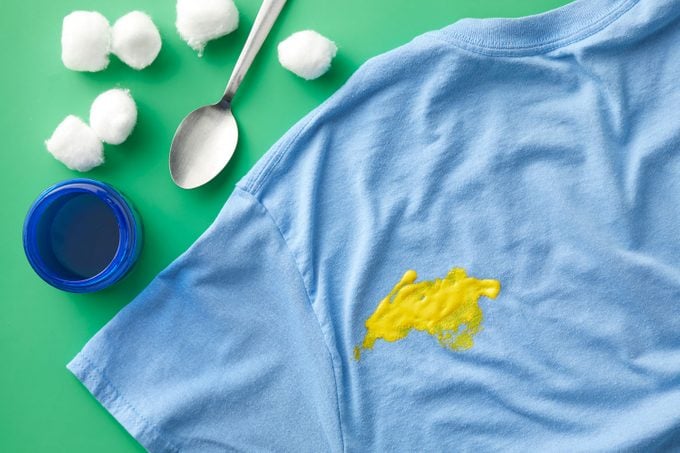
The first thing you need to know: Both latex and acrylic paint are water-based, but you still have to act fast when they get on your clothes. Latex paint is a little easier to remove because of its chemical makeup. Acrylic, on the other hand, contains plastic, which gives your paint that lovely glossy look but also dries into a film that’s “extremely stable, water-resistant, permanent and vibrant,” according to the American Chemical Society.
That said, the stain-removal process, as detailed below, is the same for both. If you’re unable to treat these types of stains right away, flush them with warm water to keep them wet until you can.
Supplies you’ll need
- Warm water
- Blunt tool, such as a spoon or an old credit card
- Cotton ball or towel
- Liquid laundry detergent
- Bucket (optional)
Step 1: Remove excess paint
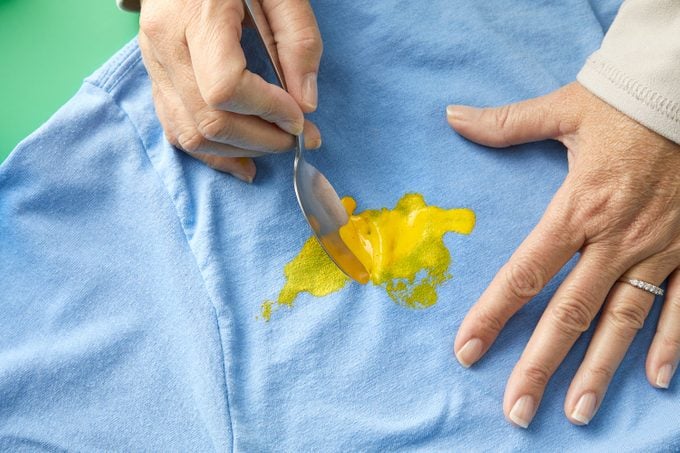
With a blunt tool, like the edge of a spoon or an old credit card, remove excess wet paint. Gently scrape in an inward direction, toward the center of the stain, to avoid spreading the stain onto unaffected fabric.
Step 2: Dab with a cotton ball
Next, dab the stain with a cotton ball or white towel. (By using a light color, you’ll be able to see how much paint transfers, unless you’re dealing with white paint, of course.) Use a clean section of the cotton ball or towel for each blot to make sure you don’t transfer the paint back onto the fabric. Do this until there is no more paint transfer.
Step 3: Flush the area with water
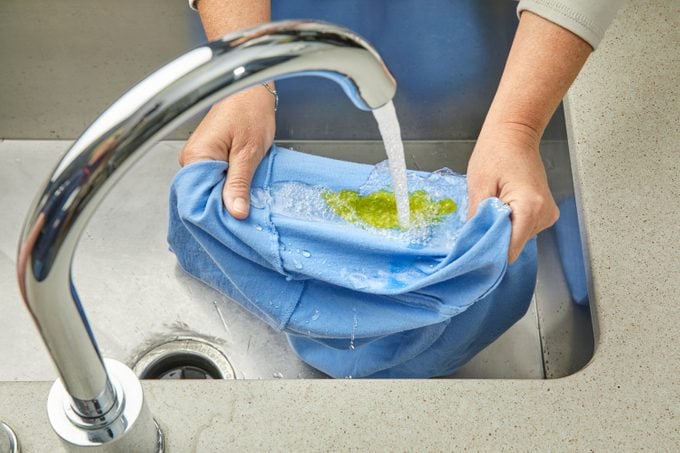
Using warm water, rinse the stain thoroughly to remove any remaining excess. Make sure to flow the water from the back of the stain so the paint isn’t further embedded into the fabric’s fibers. For best results, hold the garment in a single layer, flat and taught, under running water.
Step 4: Pre-treat the stain
Apply liquid laundry detergent on the stain, using just enough to saturate it. Add a small amount of warm water to create a lather, and gently work the solution into the stain with your fingers. (Don’t rub the fabric together, since this can damage fibers and inadvertently spread the stain to other parts of the garment.) Let the solution sit for 15 minutes.
Randall recommends Tide Ultra Stain Release, while Trusty says dish soap is also an option. That said, you will still ultimately need a laundry detergent later in the process to remove pigments, Randall notes.
Step 5: Soak the garment
While this step is optional, Randall highly recommends it. For particularly tough stains, soak the stained garment in a bucket filled with 1/4 cup liquid laundry detergent per 2 gallons of warm water for one hour.
Step 6: Launder the garment
Leaving the pre-treatment detergent on the stain, toss the garment into the washing machine (or wash by hand if that’s recommended for your garment). Use the warmest water allowed for the garment, per its care label, and a full dose of laundry detergent.
Step 7: Inspect the stain
The heat from a dryer will set stains, so make sure to inspect your garment before drying it. If any part of the stain remains, repeat Steps 4–7.
Step 8: Dry the garment
Once the stain is completely gone, dry the item as you normally would.
How to get oil-based paint out of clothes
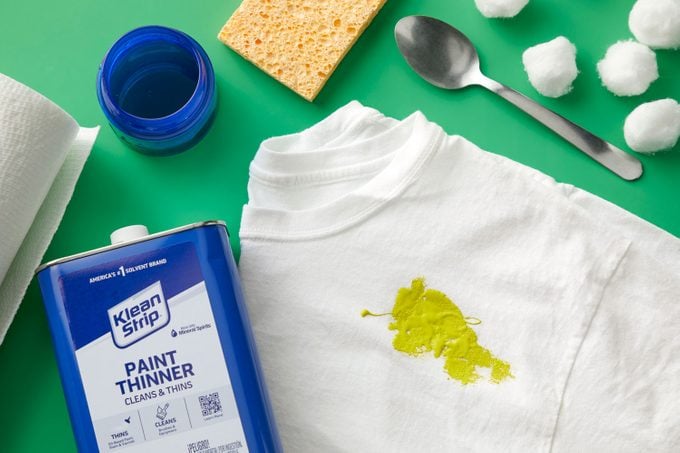
You know the phrase “oil and water don’t mix”? That, in a nutshell, is your challenge with oil-based stains. The good news is that these expert-approved tips and techniques will help you get them out—and the sooner you try them, the better.
Supplies you’ll need
- Blunt instrument, such as a spoon or an old credit card
- Cotton ball or old towel
- Paint thinner (such as mineral spirits or turpentine) or rubbing alcohol
- Paper towels
- Sponge or rag
- Liquid laundry detergent
- Warm water
- Bucket
Step 1: Remove excess paint
Gently scrape the wet stain with a spoon, the edge of an old credit card or a similarly blunt tool to remove excess paint. Work toward the center of the stain so you don’t accidentally spread it.
Step 2: Dab with a cotton ball
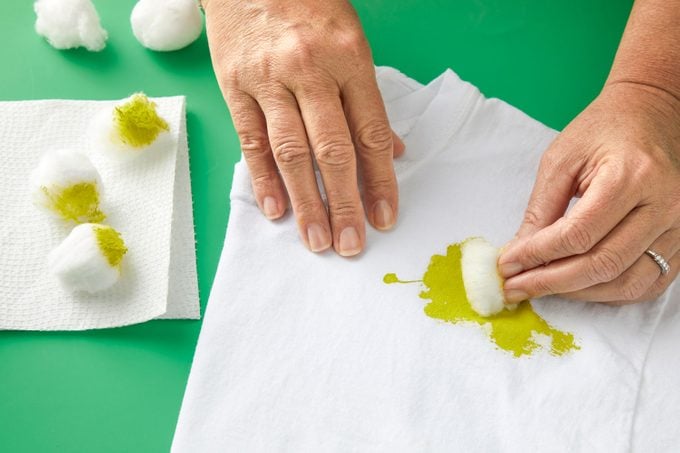
Dab any remaining wet paint with a cotton ball or an old towel until paint no longer transfers. Make sure to use a clean portion of the cotton ball or towel with each blot so you don’t transfer paint back onto the item.
Step 3: Spot-test the garment with paint thinner
Paint thinner isn’t designed to be used on fabric, and it could damage garments, especially delicate ones. Before applying it to the entire stain, try a small amount on an inconspicuous area. If damage occurs, skip to Step 6 to use a milder method (laundry detergent) or take your item to a professional. If not, proceed to the next step.
Step 4: Apply paint thinner to the stain
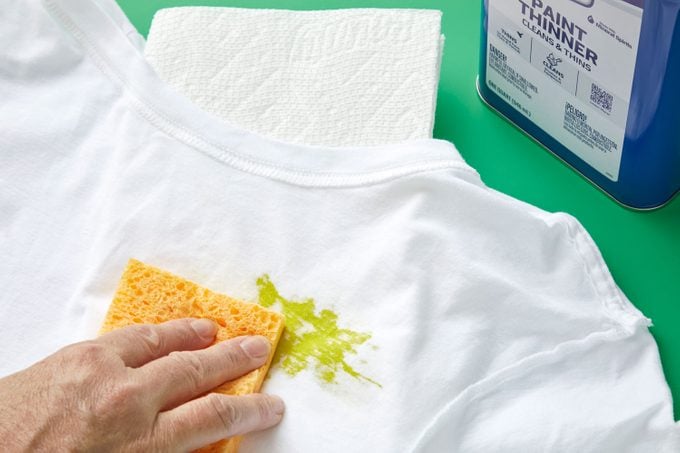
Turn the garment inside out, and set the stain over a few layers of paper towels. With a sponge or rag dampened with paint thinner (or a substitute like rubbing alcohol), lightly press it onto the stain. Use a clean part of the sponge or rag each time you blot the stain, repeating until there’s no more paint transfer.
Step 5: Rinse
Flush the affected area with warm water to remove the thinned-out paint from your garment. Rinse from the back toward the front in order to prevent the stain from traveling further into the fibers of the fabric.
Step 6: Apply liquid laundry detergent
Next, apply just enough liquid laundry detergent to saturate the stain. Add a bit of water so it lathers, and gently work it into the stain with your fingertips. Allow it to sit for 15 minutes.
Step 7: Soak the garment
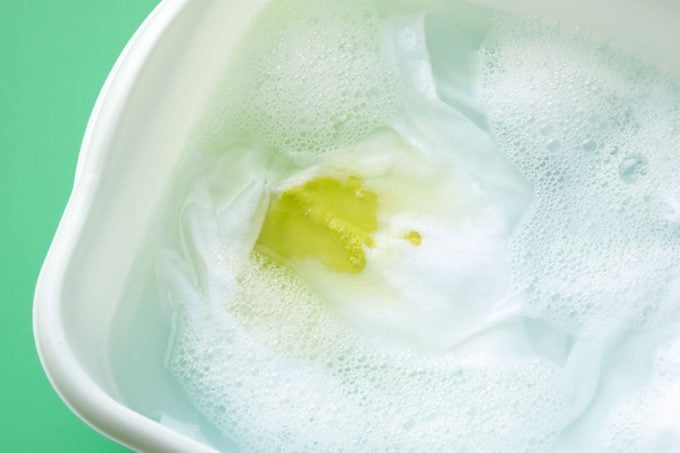
Fill a bucket with 2 gallons of warm water and 1/4 cup of liquid laundry detergent. Allow it to soak for one hour. While this step is optional for water-based paint stains, Randall says it’s essential for oil-based stains, which are harder to get out.
Step 8: Hand-wash
The solvents used to remove oil-based paints are harsh and should be throughly removed. It’s best to hand-wash your item to prevent the transfer of the solvent to other garments in the washer. My favorite way to do this is to mix water and a few drops of liquid laundry detergent in a wash bin, add the garment, swish it around gently to make suds, and soak it for up to 30 minutes before rinsing.
Step 9: Inspect the stain
While your item is still wet, inspect it to make sure the stain is completely gone. If it’s not, repeat Steps 6–9.
Step 10: Dry the garment
Once you have confirmed that the stain is gone, hang your garment to air-dry. If any solvent residue is trapped in the fibers, it can be a fire hazard to place the fabric in a hot dryer. If you’d like to use a dryer on your garment in the future, wash it as usual in the machine with your regular laundry detergent (after you wear it next) to ensure that all of the solvent has been removed.
How to get dried paint out of clothes
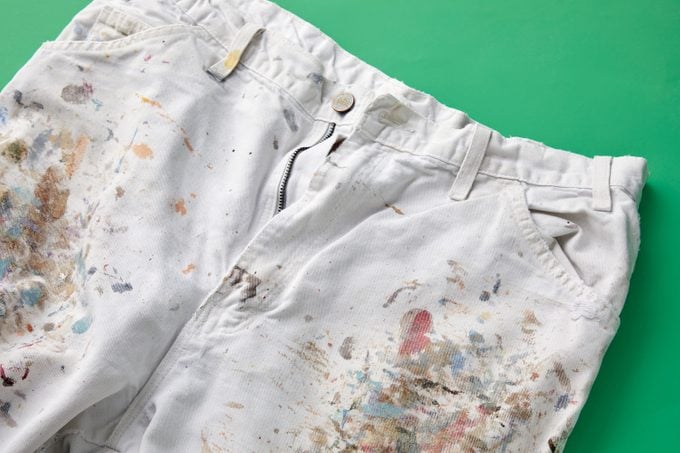
As noted earlier, dried paint is a lot harder to remove than wet paint, since it cures in the fibers of your garment. That said, if you can’t get to the stain while it’s wet, you may still be able to remove dried paint with the following strategies from Randall. But one very important note: The type of paint stain still matters here, even though it’s dry, so your strategies for water- and oil-based paint will differ slightly.
Supplies you’ll need
- Plastic knife, stiff-bristled brush or putty knife
- Paint thinner or an alcohol-based product (for oil-based paint stains)
- Dish soap or liquid laundry detergent
- Warm water
- Bowl
Step 1: Scrape off excess dried paint
If there’s any excess paint that rises above the surface of the fabric, use a plastic knife, a stiff-bristled brush or a similar tool to gently scrape off as much of it as possible. If the paint has fully saturated into the fabric, you can skip this step.
Step 2: Flush with water
Rinse the stain with warm water to remove as much of the paint as you can. Make sure to rinse from the back to the front.
Step 3: Dissolve the stain
For an oil-based paint stain, spot-test an inconspicuous area of your garment with paint thinner or rubbing alcohol. (These solutions can fade certain fabrics.) When you’ve determined it’s safe for your fabric, saturate a cotton ball with the liquid, and squeeze it onto the stained area. Let it sit for 15 minutes.
If you have a water-based paint stain, such as a latex paint stain or an acrylic paint stain, skip this step and proceed to Step 5.
Step 4: Rinse
Use warm water to flush the stain and the paint-thinning product from the back of the garment. Warm or hot water works best on all oil-based stains.
Step 5: Apply liquid detergent
Pre-treat the stained area with liquid laundry detergent. Apply enough to saturate the stain, add some warm water to lather, and gently work it into the stain with your fingers. Let the detergent sit for at least 15 minutes; this will help it break the bonds between the paint and the fabric before you move to the next step.
Step 6: Soak the garment
Since dried paint stains are the toughest to deal with, soak your garment in 2 gallons of warm water mixed with 1/4 cup of liquid laundry detergent for one hour.
Step 7: Launder the garment
If you’ve used a solvent-based product as a stain treatment, hand-wash your item to remove as much solvent as possible and prevent contamination of other fabrics. The garment can subsequently be added to your regular laundry loads. If you’re dealing with a water-based stain and haven’t used a solvent, feel free to put it in the washer, as long as it’s OK for the fabric.
Step 8: Inspect the stain
After washing your garment, inspect the stain to make sure it’s fully gone before you dry it. Drying a lingering stain can set it, so if any pigment remains, repeat Steps 5–8 until the stain is gone.
Step 9: Dry the garment
If you have used paint thinner on your garment, hang it to dry. Otherwise you can dry it in the dryer as usual.
FAQs
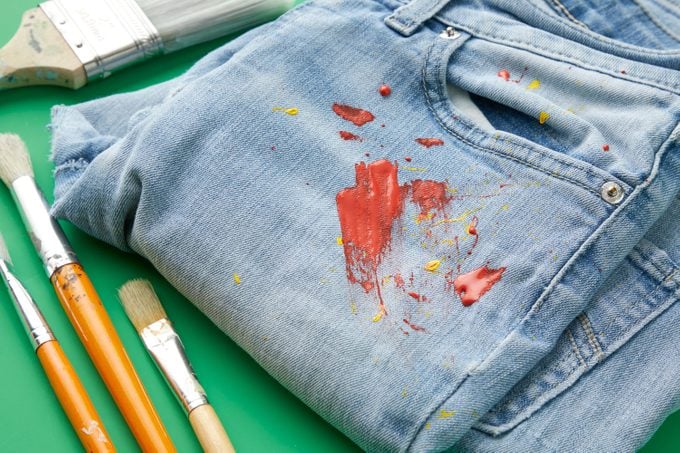
Does vinegar remove paint from clothing?
Similar to the way vinegar can break down blood stains or deodorant stains, it can help break down water-based paint stains as well. But Randall says it’s not as effective as the other methods—in fact, it’s really just the water in vinegar that’s rinsing out some of the paint. That said, vinegar is a safer alternative to paint thinner, so it won’t hurt to try it. Soak any kind of wet paint stain in a 1:1 solution of distilled white vinegar and water to see it if helps break down the stain.
Does rubbing alcohol remove paint from clothes?
As noted above, rubbing alcohol can act as a solvent to remove paint stains from clothes. You can try it as a less-harsh alternative to paint thinner when soaking oil-based paint stains. However, Randall warns that alcohol may “solubilize” dyes in fabrics—meaning it could remove the color from your clothes. So proceed with caution, and always spot-test in an inconspicuous area of your garment first.
Can nail polish remover remove paint?
Yes. Nail polish remover contains alcohol and acetone, which can thin and break down paint stains. While you can try it as a milder alternative to paint thinner on oil-based stains, you might want to go with a non-acetone version. Acetone can damage natural fibers and melt acetate-based fabrics, so you really need to be careful about which materials you use it on. Also, just like with rubbing alcohol, nail polish remover could bleach the color from your garment.
Are there other methods for getting paint out of clothing?
- Hairspray: Hairspray often contains alcohol, so it can also be used to help dissolve latex paint stains, oil-based stains or dried paint stains. Spray it on the stain, let it sit for 15 minutes, and then add liquid laundry detergent as a spot treatment, soak the garment and follow with the rest of the directions noted above.
- Hand sanitizer: Hand sanitizer also contains alcohol, so it can act as a solvent to dissolve paint stains. Experts say to use this in a pinch when you’re out and can’t easily access other methods. Dab it on, and gently agitate it into the stain. When you can, continue the stain-removal process with dish soap or laundry detergent, and wash the garment.
- Duct tape: Duct tape can help you remove flakes of dried paint. After you scrape the dried paint with a stiff-bristled brush or plastic knife, apply the duct tape to the area and peel it off. Follow with the rest of the steps for removing dried paint from clothes.
- Essential oil: Yes, essential oil can help dissolve paint stains, but be aware that the oil itself may leave a mark that needs to be treated. If you want to try this, dab the oil onto the stain, let it sit for 15 minutes, and then continue with the stain-removal process. That said, using a high-quality detergent and the recommended cleaning steps noted above is a better option, says Randall.
Why trust us
At Reader’s Digest, we’re committed to producing high-quality content by writers with expertise and experience in their field, in consultation with relevant, qualified experts. For this piece, Shifrah Combiths tapped her experience as a lifestyle journalist with more than 10 years covering home and cleaning. Then Mary Marlowe Leverette, a fabric-care and stain-removal specialist with more than 40 years of experience, gave it a rigorous review to ensure that all information is accurate and offers the best possible advice to readers. For this piece, we relied on reputable primary sources, including cleaning and health experts and reputable government agencies. We verified all facts and data and backed them with credible sourcing, and we will revisit them over time to ensure they remain accurate and up to date. Read more about our team, our contributors and our editorial policies.
Sources:
- Sherri Randall, PhD, R&D Senior Director and research fellow at Tide; email interview, Feb. 2, 2024
- Tony Trusty, owner and operator of Shamrock Cleaners; phone interview, Jan. 17, 2024
- Cameron Mitchell, salesperson at Benjamin Moore; phone interview, Jan. 17, 2024
- Persil: “How to Get Paint Out of Clothes”
- Home Depot: “Indoor Paint Buying Guide”
- American Chemical Society: “What’s in Your Paintbox?”



